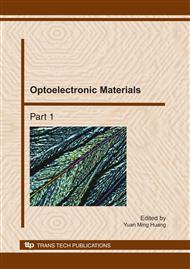p.890
p.894
p.898
p.902
p.906
p.910
p.914
p.918
p.922
A Simple and Novel Method for Large-Scale Preparation of Stable Copper Nanoparticles
Abstract:
A simple and novel preparation method for Cu nanoparticles has been suggested in this work. Its main innovative thought lies in preparing nano-copper in liquid paraffin without addition of other reductant. The paraffin is cheap and nontoxic, and the copper nanoparticles prepared by this method are not oxidized when exposed to air at room temperature. The obtained nano-copper has been characterized by X-ray diffraction measurements (XRD), scanning electron microscopy (SEM), transmission electron microscope (TEM), and energy dispersive analysis of X-ray (EDX), X-ray photoelectron spectra (XPS), and Fourier transform infrared spectroscopy (FTIR). The TEM results confirm that the optimal average size of nanoparticles is about 20 nm. The effects of time, temperature and surfactant on the size of nano-copper have been investigated. The results show that the optimized conditions are reaction temperature of 250 oC and reaction time of 3 h. By this method, the raw materials are cheap and the process is simple, so it can be applicable to large-scale production of copper nanoparticles.
Info:
Periodical:
Pages:
906-909
Citation:
Online since:
November 2010
Authors:
Keywords:
Price:
Сopyright:
© 2011 Trans Tech Publications Ltd. All Rights Reserved
Share:
Citation:


